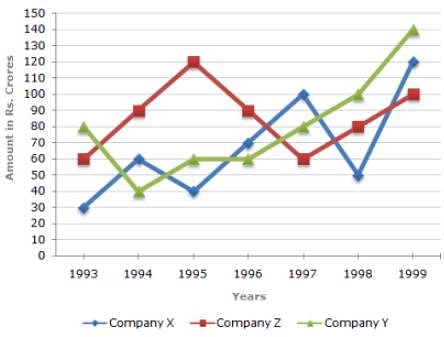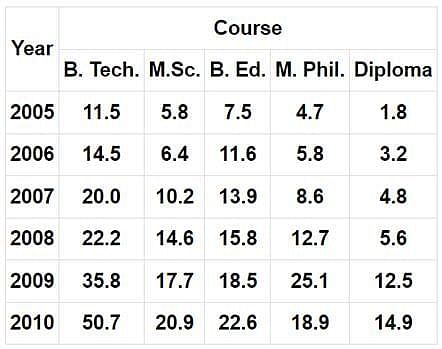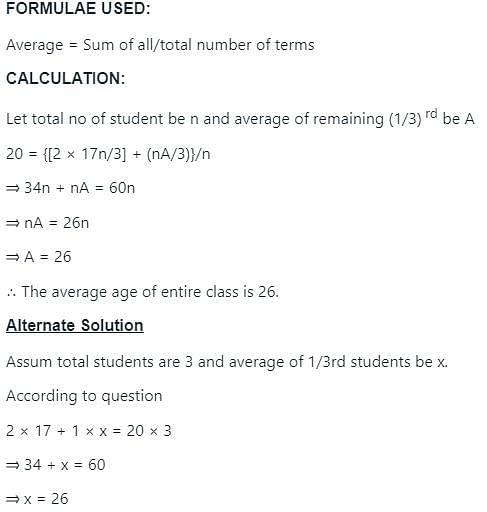BSF Head Constable Mock Test - 10 - CDS MCQ
30 Questions MCQ Test - BSF Head Constable Mock Test - 10
In the context of the Indian freedom struggle, 16th October 1905 is well known for which one of the following reasons?
Which one among the following industries is the maximum consumer of water in India?
| 1 Crore+ students have signed up on EduRev. Have you? Download the App |
Which company has signed a contract with the Indian Defence Ministry for the refit of submarine INS Shankush?
Where was India's first 'Police Drone Unit' launched?
Where was the 17th Indian Cooperative Congress inaugurated?
How much financing has the World Bank approved to support India's low-carbon transition?
Study the following line graph and answer the questins.
Exports from Three Companies Over the Years (in Rs. crore)

Q. In which year was the difference between the exports from Companies X and Y the minimum?
The average age of 2/3rd of the class is 17. What should be the average the age of the remaining l/3rd students so that the average age of the entire class is 20?
What is the simple interest for 9 years on a sum of Rs. 800 if the rate of interest for the first 4 years is 8% per annum and for the last 4 years is 6% per annum?
Find the compound interest on Rs. 1000 at the rate of 20% per annum for 18 months when interest is compounded half-yearly.
If the positions of the digits of a two digit number are interchanged, the number obtained is smaller than the original number by 27. If the digits of the number are in the ratio of 1:2, what is the original number?
Find the least number which when divided by 12, 27 and 35 leaves 6 as a remainder?
The number of seats in a cinema hall is decreased by 8% and also the price of the ticket is increased by 4 percent. What is the effect on the revenue collected?
A is working and B is the sleeping partner in a business. A invests Rs. 12,000 and B invests Rs. 20,000. A receives 10% of the profit for managing. The rest is divided in the ratio of their capitals. Out of a total profit of Rs. 9600, what will be the amount received by A?
The sum of three numbers is 98. The ratio of the first two numbers is 2 : 3 and that of the last two numbers is 5 : 8. Find the 2nd number.
There are two shops, A and B. Shop A gives successive discounts of 60% and 40%, whereas shop B gives successive discounts of 30% and 70%. If the selling price of an article is the same in both the shops, then what is the ratio of marked prices of the article in the two shops?
Directions: Study the following table carefully and answer the questions that follow:
Semester fees (In Rs. thousands) for five Different Courses in 6 different years.

Q. What was the average semester fee charged for M. Sc. course over all the years together?
Directions: Study the following table carefully and answer the questions that follow:
Semester fees (In Rs. thousands) for five Different Courses in 6 different years.

Q. The semester fee charged for M. Phil course in the year 2008 was approximately what percentage of the semester fee charged for M. Sc course in the year 2009?
Directions: Study the following bar chart carefully and answer the questions given beside.
Public Sector Outlay (in percentage) of different sectors is given below.

Q. Public sector outlay was Rs. 40,000 crores in the fifth plan and around Rs.1 lakh crores in the sixth plan. What is the percentage increase in the amount spent towards Energy sector from the fifth plan to the sixth plan?
Find out the Synonym of the following word:
ADVERSITY
Find out the Synonym of the following word:
FAKE
Praise for Johnny Starstruck and his entourage are common, although statisticsshow Americans still associate his name with the ritualistic murders.
If seriously mentally ill people do not receive medication, they can grow unable tosupport themselves, become irrational, and perhaps even threatening the safetyof themselves or others.
If sentence (3), 'In most economic systems, the prices of the majority of goods and services do not change over short periods of time' is the first sentence, what is the order of other sentences after rearrangement?
1. In some, it is of course possible for an individual to bargain over prices, because they are not fixed in advance.
2. When planning his expenditure, he must therefore accept these fixed prices.
3. In most economic systems, the prices of the majority of goods and services do not change over short periods of time.
4. A consumer will go on buying bananas for as long as he continues to be satisfied.
5. If he buys more, he shows that his satisfaction is still greater than his dislike of losing money.
6. In general terms, however, the individual cannot change the prices of the commodities he wants.
Directions: Rearrange the following six sentences (1), (2), (3), (4), (5) and (6) in the proper sequence to form a meaningful paragraph and then answer the question given below.
1. Officials of the Russian-American Company reasoned that a permanent settlement along the more temperate shores of California could serve both as a source of food and a base for exploiting the abundant sea otters in the region.
2. The Russians had begun their expansion into the North American continent in 1741 with a massive scientific expedition to Alaska.
3. By the early 19th century, the semi-governmental Russian-American Company was actively competing with British and American fur-trading interests as far south as the shores of Spanish-controlled California.
4. As a growing empire with a long Pacific coastline, Russia was in many ways well positioned to play a leading role in the settlement and development of the West.
5. Returning with news of abundant sea otters, the explorers inspired Russian investment in the Alaskan fur trade and some permanent settlement.
6. Russia's Alaskan colonists found it difficult to produce their own food because of the short growing season of the far north.
Q. Which of following is the FOURTH sentence after rearrangement?
Directions: Read the passage and answer the questions that follow:
Development is about expanding the capabilities of the disadvantaged, thereby improving their overall quality of life. Based on this understanding, Maharashtra, one of India’s richest States, is a classic case of a lack of development which is seen in its unacceptably high level of malnutrition among children in the tribal belts. While the State’s per capita income has doubled since 2004, its nutritional status has not made commensurate progress.
Poor nutrition security disproportionately affects the poorest segment of the population. According to NFHS 2015-16, every second tribal child suffers from growth restricting malnutrition due to chronic hunger. In 2005, child malnutrition claimed as many as 718 lives in Maharashtra’s Palghar district alone. Even after a decade of double digit economic growth (2004-05 to 2014-15), Palghar’s malnutrition status has barely improved.
In September 2016, the National Human Rights Commission issued notice to the Maharashtra government over reports of 600 children dying due to malnutrition in Palghar. The government responded, promising to properly implement schemes such as Jaccha Baccha and Integrated Child Development Services to check malnutrition. Our independent survey conducted in Vikramgad block of the district last year found that 57%, 21% and 53% of children in this block were stunted, wasted and underweight, respectively; 27% were severely stunted. Our data challenges what Maharashtra’s Women and Child Development Minister said in the Legislative Council in March — that “malnutrition in Palghar had come down in the past few months, owing to various interventions made by the government.”
Stunting is caused by an insufficient intake of macro- and micro-nutrients. It is generally accepted that recovery from growth retardation after two years is only possible if the affected child is put on a diet that is adequate in nutrient requirements. A critical aspect of nutrient adequacy is diet diversity, calculated by different groupings of foods consumed with the reference period ranging from one to 15 days. We calculated a 24-hour dietary diversity score by counting the number of food groups the child received in the last 24 hours. The eight food groups include: cereals, roots and tubers; legumes and nuts; dairy products; flesh foods; eggs; fish; dark green leafy vegetables; and other fruits and vegetables.
In most households it was rice and dal which was cooked most often and eaten thrice a day. These were even served at teatime to the children if they felt hungry. There was no milk, milk product or fruit in their daily diets. Even the adults drank black tea as milk was unaffordable. Only 17% of the children achieved a minimum level of diet diversity — they received four or more of the eight food groups. This low dietary diversity is a proxy indicator for the household’s food security too as the children ate the same food cooked for adult members.
Q. As per the passage, which of the following is/are needed for an adequate meal?
I. Macro and micro nutrients
II. Multiple food groups
III. High level of Intermittent fasting
Directions: Read the passage and answer the questions that follow:
Development is about expanding the capabilities of the disadvantaged, thereby improving their overall quality of life. Based on this understanding, Maharashtra, one of India’s richest States, is a classic case of a lack of development which is seen in its unacceptably high level of malnutrition among children in the tribal belts. While the State’s per capita income has doubled since 2004, its nutritional status has not made commensurate progress.
Poor nutrition security disproportionately affects the poorest segment of the population. According to NFHS 2015-16, every second tribal child suffers from growth restricting malnutrition due to chronic hunger. In 2005, child malnutrition claimed as many as 718 lives in Maharashtra’s Palghar district alone. Even after a decade of double digit economic growth (2004-05 to 2014-15), Palghar’s malnutrition status has barely improved.
In September 2016, the National Human Rights Commission issued notice to the Maharashtra government over reports of 600 children dying due to malnutrition in Palghar. The government responded, promising to properly implement schemes such as Jaccha Baccha and Integrated Child Development Services to check malnutrition. Our independent survey conducted in Vikramgad block of the district last year found that 57%, 21% and 53% of children in this block were stunted, wasted and underweight, respectively; 27% were severely stunted. Our data challenges what Maharashtra’s Women and Child Development Minister said in the Legislative Council in March — that “malnutrition in Palghar had come down in the past few months, owing to various interventions made by the government.”
Stunting is caused by an insufficient intake of macro- and micro-nutrients. It is generally accepted that recovery from growth retardation after two years is only possible if the affected child is put on a diet that is adequate in nutrient requirements. A critical aspect of nutrient adequacy is diet diversity, calculated by different groupings of foods consumed with the reference period ranging from one to 15 days. We calculated a 24-hour dietary diversity score by counting the number of food groups the child received in the last 24 hours. The eight food groups include: cereals, roots and tubers; legumes and nuts; dairy products; flesh foods; eggs; fish; dark green leafy vegetables; and other fruits and vegetables.
In most households it was rice and dal which was cooked most often and eaten thrice a day. These were even served at teatime to the children if they felt hungry. There was no milk, milk product or fruit in their daily diets. Even the adults drank black tea as milk was unaffordable. Only 17% of the children achieved a minimum level of diet diversity — they received four or more of the eight food groups. This low dietary diversity is a proxy indicator for the household’s food security too as the children ate the same food cooked for adult members.
Q. What could possibly be a/some possible reason/s for such extreme food insecurity among tribal households as has been shown in the passage?
I. Loss of their traditional dependence on forest livelihood.
II. Weak implementation of public nutrition schemes.
III. A worsening agriculture situation.





















